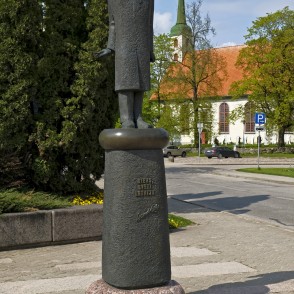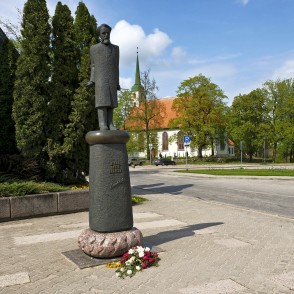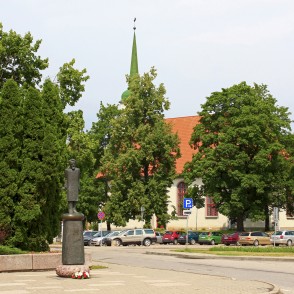Monument to Composer and Author of the Latvia National Anthem Kārlis Baumanis
Located at the intersection of Dailes Street and Cēsu Street. The bronze monument was unveiled in 1998 (by sculptors Z. Rapa and J. Rapa).
"Dievs, sveti Latviju!" ("God bless Latvia!") is the national anthem. The words and music were written by Karlis Baumanis (better known as Baumanu Karlis). The anthem first appeared in the second half of the 19th century when the Latvian people were beginning to openly exhibit a strong sense of national pride and identity. Karlis Baumanis was the first Latvian composer to use the word "Latvia" in a song lyric. The concept of "Latvia" had only began to take shape in the minds of writers and activists and was used to describe all regions traditionally inhabited by Latvians. Although most Latvians did not yet dare to dream of a sovereign state totally independent of the Tsarist Russian Empire, the song "Dievs, sveti Latviju!" served as a powerful catalyst for the emerging national consciousness. The use of the word "Latvia" in the song was an open challenge to the Tsarist regime that had little sympathy for national movements.
Initially, Russian authorities forbid the use of the word "Latvia" in the title and text of the song and it was replaced by the word "Baltics". It was performed publicly in June of 1873 at the First Song Festival in Riga. It was first sung as a national anthem on November 18, 1918 at the proclamation of Latvia's independence. On June 7, 1920 "Dievs, sveti Latviju!" was officially proclaimed the national anthem of the Republic of Latvia.
When the communists annexed Latvia in June 1940 the national flag, coat of arms and anthem became illegal within Latvia itself for 50 years. Many people were persecuted simply for keeping and hiding the red-white-red flag or singing the national anthem. But the official symbols of Latvia were never forgotten and the struggle to bring the national red-white-red colours back into use marked the beginning of a renewed struggle for independence at the end of the 1980s.
© The Latvian Institute




